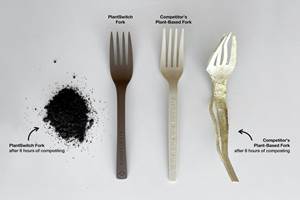Biopolymers: Time to Take A Deep Breath
Are we looking at all of the implications associated with developing this new 'crop' of polymers?
The enthusiasm for polymers made from biologically derived materials is understandable. After years of plastics being assailed by environmental groups, the media, and the general public for being “part of the problem” of consumption of fossil fuels, it undoubtedly feels good to be able to point to the growing sector of biopolymers as evidence that the plastics industry is acting in a conscientious and proactive manner. It is consistent with the ethic behind already worn-out terms such as green and sustainable.
This newfound enthusiasm for a sector of the industry that seems to have finally reached critical mass after 35 years of painfully slow and uneven development has given rise to some bold and even outrageous predictions regarding the degree to which biopolymers will replace oil-derived plastics as this century unfolds. One online survey that was posted recently asked a question to the effect of, “How soon will biopolymers displace oil-based polymers as the dominant class of materials used in the plastics industry?” The multiple choice menu contained options like 10 years and 25 years. I checked “Never.”
Never is a long time, but my answer was motivated less by a belief that it can’t happen than by a conviction that it should not happen, at least in its current incarnation.
Deriving propanediol from grains or ethylene from sugar cane may sound like a good idea. However, this is an extension of the strategy that introduced alcohol derived from corn to the motor-fuel industry. This approach has contributed to a substantial increase in the price of food as the supply of staples has been reduced in favor of growing crops for fuel. This has gone largely unnoticed in Europe and the U.S., where the cost of food does not constitute the percentage of the family budget that it does in developing nations.
But it has had a large impact on the ability of large segments of the world’s population to feed itself.
There are some inescapable facts to be confronted about the state of food production in the world today and the growing problem of feeding a rapidly expanding population. And it begins with the fact that approximately 1 billion of the 7 billion inhabitants on the planet already suffer from chronic hunger. This is a conservative estimate; some place the number closer to 2 billion.
Add to this the projection that by 2050 we will add another 2 billion to 3 billion people, and that those already living or yet to be born into countries with rapidly developing economies will consume more food, and the best estimates indicate that world food production will need to double in the next 40 years. It is not entirely clear that this is an attainable objective given the fractured nature of the world political system. However, it is clear that one thing that is not needed to add further to the burden of meeting this objective is diverting large amounts of food crops to production of polymers.
As things stand, only 60% of the food grown today ends up going directly to human consumption. An additional 35% is used for animal feed. It takes 30 lb of grain to make 1 lb of edible, boneless beef. The other 5% already goes to biofuels and other industrial products, including our burgeoning biopolymer sector.
The argument is made that the products grown for animals and industry do not detract from the human food sources since these products are not fit for human consumption.
One night while coping with a bout of severe insomnia, I watched Congressional proceedings on C-Span where testimony to this effect was being given to Congress by representatives of Big Alcohol. But this defense ignores the reality that there is a finite amount of land on which crops can be grown, and if the economic incentives dictate that crops will sell for higher prices when made into biofuels and biopolymers than when made into food, then land will be set aside to do just that.
Market theory would respond to this by using more land to produce all of the needed products. And this brings us to the next issue, the impact that agriculture has had on our environment. Only energy production has had a greater impact on our environment than agriculture. Agriculture is the largest single source of greenhouse gases, accounting for 35% of all the carbon dioxide, methane, and nitrous oxide that we release. This is more than the worldwide emissions from transportation or electricity generation. In addition, agriculture has cleared or significantly transformed large percentages of prehistoric grasslands, savannahs, and temperate and tropical forests.
Finally, fresh water has been part of the collateral damage associated with agriculture. Irrigation has drawn so much volume away from natural waterways that many large rivers, such as the Colorado, have diminished flows or have dried up altogether, and many places have rapidly declining water tables, including regions in the U.S. And where water is not disappearing it is being contaminated. Fertilizers, herbicides, and pesticides are ubiquitous. While fertilizers have been an important ingredient in improved agricultural yields, nearly half of the applied fertilizer runs off and ends up in coastal waters where it impacts fishing grounds, another key element in the cycle of food production. And fish do not require large allotments of grain to be converted into food.
Kermit the Frog had it right: It’s not easy being green. Before we rush to replace petroleum with “renewable resources,” we need to pause, take a breath, and truly understand the impact of siphoning off key resources designed to feed people to make our polymers.
Biopolymers are an inherently good idea. But if this is to be done in a sustainable way, to use the vernacular, we need to make them from the parts of the plant that we do not eat or from crops that can grow in places and under conditions that would not sustain food production and therefore do not compete for those resources. Then we can get down to answering the technological questions regarding where biopolymers fit when it comes to requirements for efficient processing and the properties they offer relative to the incumbents.
Related Content
NPE2024 Materials: Spotlight on Sustainability with Performance
Across the show, sustainability ruled in new materials technology, from polyolefins and engineering resins to biobased materials.
Read MoreAdvanced Biobased Materials Company PlantSwitch Gets Support for Commercialization
With participation from venture investment firm NexPoint Capital, PlantSwitch closes it $8M bridge financing round.
Read MoreICIS Launches: Ask ICIS Generative AI Commodities Assistant
Said to be the first of its kind, this AI assistant will enhance access to ICIS’ intelligence and insights for the energy and chemical markets.
Read MoreAt NPE2024, Follow These Megatrends in Materials and Additives
Offerings range from recycled, biobased, biodegradable and monomaterial structures that enhance recyclability to additives that are more efficient, sustainable and safer to use.
Read MoreRead Next
Making the Circular Economy a Reality
Driven by brand owner demands and new worldwide legislation, the entire supply chain is working toward the shift to circularity, with some evidence the circular economy has already begun.
Read MorePrecision Processing Requires Precision Equipment
Moretto offers plastics processors and micromolders for a broad suite of auxiliary solutions targeted specifically for precision processing.
Read MoreSee Recyclers Close the Loop on Trade Show Production Scrap at NPE2024
A collaboration between show organizer PLASTICS, recycler CPR and size reduction experts WEIMA and Conair recovered and recycled all production scrap at NPE2024.
Read More
.jpg;width=70;height=70;mode=crop)














